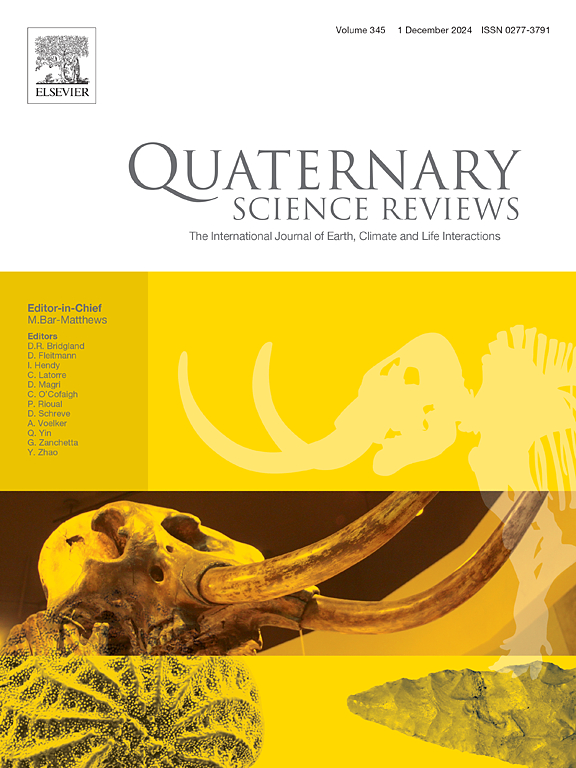A watery ice sheet demise: Formation and drainage of ice-dammed lakes in Southern Norway during the Early Holocene
IF 3.2
1区 地球科学
Q1 GEOGRAPHY, PHYSICAL
引用次数: 0
Abstract
The final demise of the Scandinavian Ice Sheet in southern Norway was associated with partial glacial retreat in ice-dammed lakes, but how the subaqueous retreat affected glacial dynamics is largely unknown. Here, we present results from comprehensive mapping that demonstrate the existence and final catastrophic drainage of multiple ice-dammed lakes in southern Norway during the Early Holocene, as well as key landforms that detail the course of glacial retreat. We have identified several previously unknown ice-dammed lakes and described three hitherto unknown 15–80 km3-large glacial lake outburst floods. The floods formed mega dunes, large flood bars, canyons and other distinctive features in the impacted areas downstream. We present a relative chronology for the ice-dammed lakes and drainage events that, coupled with existing chronological constraints, allow detailed palaeoglaciology reconstructions in a period of rapid deglaciation. The ice-dammed lake record documents that the mountainous areas became ice-free first, whereas the large inland valleys in southern Norway were deglaciated last. The very last remnants of the Scandinavian Ice Sheet in southern Norway were probably located in the valleys around Jotunheimen. The ice-dammed lakes induced dynamic glacial retreat and probably caused a significant increase in ice-sheet drawdown and retreat rates compared to where glacial retreat was land-based, e.g. as indicated by a near tenfold increase in retreat rates when the Store Dølasjø ice-dammed lake formed, and the glacier became water-terminating. The study highlights the value of ice-dammed lakes for reconstructing palaeo-ice sheets, and the data serve as a relevant analogue for future ice mass loss in glacierized regions worldwide.
水冰盖的消亡:全新世早期挪威南部冰坝湖泊的形成和排水
挪威南部斯堪的纳维亚冰盖的最终消亡与冰坝湖泊的部分冰川退缩有关,但水下退缩如何影响冰川动力学在很大程度上是未知的。在这里,我们展示了综合制图的结果,这些结果证明了全新世早期挪威南部多个冰坝湖泊的存在和最终的灾难性排水,以及详细描述冰川退缩过程的关键地貌。我们已经确定了几个以前未知的冰坝湖泊,并描述了三个迄今为止未知的15-80 km2的冰湖溃决洪水。洪水在下游受影响地区形成了巨型沙丘、大型洪坝、峡谷等特征。我们提出了冰坝湖泊和排水事件的相对年代学,结合现有的年代学限制,可以在快速消冰时期详细地重建古冰川学。冰封的湖泊记录了山区首先成为无冰地区,而挪威南部的大型内陆山谷是最后一个冰川消融的地区。挪威南部斯堪的纳维亚冰盖的最后遗迹可能位于约通海门周围的山谷中。冰坝湖诱发了冰川的动态退缩,与陆地冰川退缩相比,可能导致冰盖退缩和退缩率的显著增加,例如,当Store Dølasjø冰坝湖形成时,退缩率增加了近10倍,冰川成为水终止。该研究强调了冰坝湖对重建古冰盖的价值,并且这些数据可以作为全球冰川化地区未来冰质量损失的相关模拟。
本文章由计算机程序翻译,如有差异,请以英文原文为准。
求助全文
约1分钟内获得全文
求助全文
来源期刊

Quaternary Science Reviews
地学-地球科学综合
CiteScore
7.50
自引率
15.00%
发文量
388
审稿时长
3 months
期刊介绍:
Quaternary Science Reviews caters for all aspects of Quaternary science, and includes, for example, geology, geomorphology, geography, archaeology, soil science, palaeobotany, palaeontology, palaeoclimatology and the full range of applicable dating methods. The dividing line between what constitutes the review paper and one which contains new original data is not easy to establish, so QSR also publishes papers with new data especially if these perform a review function. All the Quaternary sciences are changing rapidly and subject to re-evaluation as the pace of discovery quickens; thus the diverse but comprehensive role of Quaternary Science Reviews keeps readers abreast of the wider issues relating to new developments in the field.
 求助内容:
求助内容: 应助结果提醒方式:
应助结果提醒方式:


